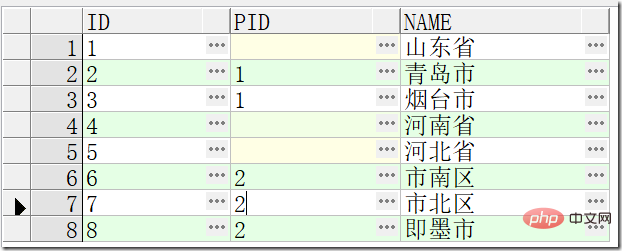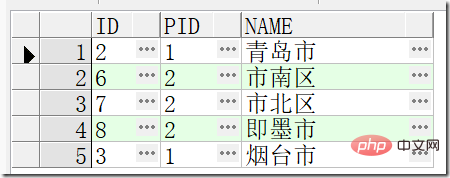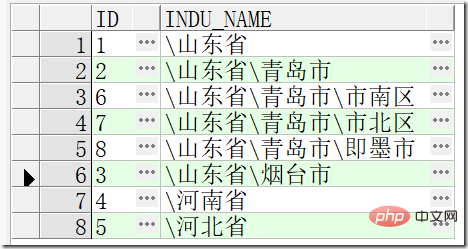One article analyzing ORACLE tree structure query
This article brings you relevant knowledge about Oracle. It mainly introduces the article about parsing ORACLE tree structure query. The article expands on the topic in detail. Let’s take a look at it together. I hope Helpful to everyone.

Recommended tutorial: "Oracle Video Tutorial"
In our daily programming, we often encounter tree structures Represents, for example, organizational structures, administrative divisions, etc. These are often displayed through a table in the database. Here we take a simple administrative division table as an example. In actual use, other description fields and levels can be added to it.

#The table is associated with ID and PID to achieve tree structure storage. The table creation and data statements are as follows:
-- Create table create table TREETEST ( id NVARCHAR2(50), pid NVARCHAR2(50), name NVARCHAR2(50) )
insert into TREETEST (ID, PID, NAME) values ('1', null, '山东省'); insert into TREETEST (ID, PID, NAME) values ('2', '1', '青岛市'); insert into TREETEST (ID, PID, NAME) values ('3', '1', '烟台市'); insert into TREETEST (ID, PID, NAME) values ('4', null, '河南省'); insert into TREETEST (ID, PID, NAME) values ('5', null, '河北省'); insert into TREETEST (ID, PID, NAME) values ('6', '2', '市南区'); insert into TREETEST (ID, PID, NAME) values ('7', '2', '市北区'); insert into TREETEST (ID, PID, NAME) values ('8', '2', '即墨市');
How to query the tree structure? Oracle provides recursive query for query. The basic syntax is as follows:
SELECT [Column]….. FEOM [Table] WHERE Conditional1 START WITH Conditional2 CONNECT BY PRIOR Conditional3 ORDER BY [Column]
Description:
- Condition 1---Filter conditions, for all Returned records are filtered.
- Condition 2---The limiting condition of the root node. Of course, you can also relax the permissions to obtain multiple root nodes, that is, obtain multiple trees
- Condition 3---The link condition, the purpose is Give what is the relationship between father and son, and perform a recursive query based on this relationship (in the above table, ID=PID)
- Sort---Sort all returned records
Let’s look at specific examples below:
1. Query all sub-nodes under Shandong Province
SELECT * FROM TREETEST t START WITH t.PID=1 CONNECT BY PRIOR t.ID = t.PID
where the ID is 1 is the node of Shandong Province, and the query results are as follows:

#2. Query the next-level child node of Qingdao City (note the difference from the above, all Child nodes and next-level child nodes)

3. If you need to connect Qingdao City, Shandong Province, etc. to display, you can use SYS_CONNECT_BY_PATH to achieve this
SELECT t.ID, SYS_CONNECT_BY_PATH(t.NAME, '\') AS INDU_NAME FROM TREETEST t START WITH t.PID IS NULL CONNECT BY PRIOR t.ID = t.PID
The query results are as follows:

4. In the same way, you can also proceed from bottom to top. Query
SELECT * FROM TREETEST t START WITH t.ID=8 CONNECT BY t.ID = PRIOR t.PID

Recommended tutorial: "Oracle Video Tutorial"
The above is the detailed content of One article analyzing ORACLE tree structure query. For more information, please follow other related articles on the PHP Chinese website!

Hot AI Tools

Undresser.AI Undress
AI-powered app for creating realistic nude photos

AI Clothes Remover
Online AI tool for removing clothes from photos.

Undress AI Tool
Undress images for free

Clothoff.io
AI clothes remover

AI Hentai Generator
Generate AI Hentai for free.

Hot Article

Hot Tools

Notepad++7.3.1
Easy-to-use and free code editor

SublimeText3 Chinese version
Chinese version, very easy to use

Zend Studio 13.0.1
Powerful PHP integrated development environment

Dreamweaver CS6
Visual web development tools

SublimeText3 Mac version
God-level code editing software (SublimeText3)

Hot Topics
 How long will Oracle database logs be kept?
May 10, 2024 am 03:27 AM
How long will Oracle database logs be kept?
May 10, 2024 am 03:27 AM
The retention period of Oracle database logs depends on the log type and configuration, including: Redo logs: determined by the maximum size configured with the "LOG_ARCHIVE_DEST" parameter. Archived redo logs: Determined by the maximum size configured by the "DB_RECOVERY_FILE_DEST_SIZE" parameter. Online redo logs: not archived, lost when the database is restarted, and the retention period is consistent with the instance running time. Audit log: Configured by the "AUDIT_TRAIL" parameter, retained for 30 days by default.
 Function to calculate the number of days between two dates in oracle
May 08, 2024 pm 07:45 PM
Function to calculate the number of days between two dates in oracle
May 08, 2024 pm 07:45 PM
The function in Oracle to calculate the number of days between two dates is DATEDIFF(). The specific usage is as follows: Specify the time interval unit: interval (such as day, month, year) Specify two date values: date1 and date2DATEDIFF(interval, date1, date2) Return the difference in days
 The order of the oracle database startup steps is
May 10, 2024 am 01:48 AM
The order of the oracle database startup steps is
May 10, 2024 am 01:48 AM
The Oracle database startup sequence is: 1. Check the preconditions; 2. Start the listener; 3. Start the database instance; 4. Wait for the database to open; 5. Connect to the database; 6. Verify the database status; 7. Enable the service (if necessary ); 8. Test the connection.
 How much memory does oracle require?
May 10, 2024 am 04:12 AM
How much memory does oracle require?
May 10, 2024 am 04:12 AM
The amount of memory required by Oracle depends on database size, activity level, and required performance level: for storing data buffers, index buffers, executing SQL statements, and managing the data dictionary cache. The exact amount is affected by database size, activity level, and required performance level. Best practices include setting the appropriate SGA size, sizing SGA components, using AMM, and monitoring memory usage.
 How to use interval in oracle
May 08, 2024 pm 07:54 PM
How to use interval in oracle
May 08, 2024 pm 07:54 PM
The INTERVAL data type in Oracle is used to represent time intervals. The syntax is INTERVAL <precision> <unit>. You can use addition, subtraction, multiplication and division operations to operate INTERVAL, which is suitable for scenarios such as storing time data and calculating date differences.
 How to see the number of occurrences of a certain character in Oracle
May 09, 2024 pm 09:33 PM
How to see the number of occurrences of a certain character in Oracle
May 09, 2024 pm 09:33 PM
To find the number of occurrences of a character in Oracle, perform the following steps: Get the total length of a string; Get the length of the substring in which a character occurs; Count the number of occurrences of a character by subtracting the substring length from the total length.
 How to replace string in oracle
May 08, 2024 pm 07:24 PM
How to replace string in oracle
May 08, 2024 pm 07:24 PM
The method of replacing strings in Oracle is to use the REPLACE function. The syntax of this function is: REPLACE(string, search_string, replace_string). Usage steps: 1. Identify the substring to be replaced; 2. Determine the new string to replace the substring; 3. Use the REPLACE function to replace. Advanced usage includes: multiple replacements, case sensitivity, special character replacement, etc.
 Oracle database server hardware configuration requirements
May 10, 2024 am 04:00 AM
Oracle database server hardware configuration requirements
May 10, 2024 am 04:00 AM
Oracle database server hardware configuration requirements: Processor: multi-core, with a main frequency of at least 2.5 GHz. For large databases, 32 cores or more are recommended. Memory: At least 8GB for small databases, 16-64GB for medium sizes, up to 512GB or more for large databases or heavy workloads. Storage: SSD or NVMe disks, RAID arrays for redundancy and performance. Network: High-speed network (10GbE or higher), dedicated network card, low-latency network. Others: Stable power supply, redundant components, compatible operating system and software, heat dissipation and cooling system.






